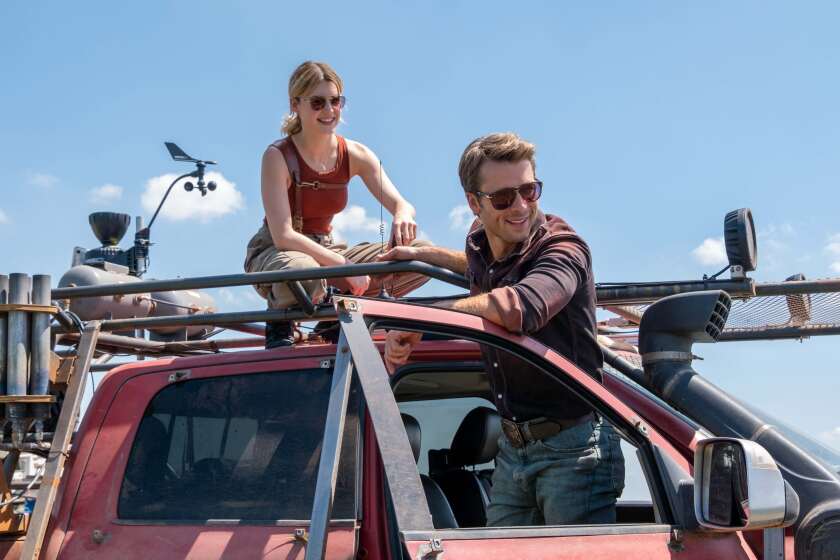A Full-Tilt ‘Romeo’
For those who have not had the experience, watching Baz Luhrmann’s brash take on “William Shakespeare’s Romeo & Juliet” simulates having a teenager in the house.
Like flaming youth everywhere, this film is loud, exuberant and excessive, but it has enough positive energy and dizzying high spirits to make it irresistible.
A wild-in-the-streets version of the classic romance that is desperate not to be your father’s Shakespeare, this “Romeo” follows in the path of Franco Zeffirelli’s 1968 film by having youthful actors, Leonardo DiCaprio and Claire Danes in this case, playing the protagonists.
But director and co-screenwriter Luhrmann, working with many of the key creative people that made his “Strictly Ballroom” debut so special, has done nothing else familiar. Juiced to the max and drenched in style, this “Romeo,” mad about its image-a-minute visual agenda, is sure to infuriate as much as it delights. But the film can’t be bothered to slow down for your reaction, and it never forgets its duty to be alive on the screen.
Given this all-around bravado, squealing tires and dance-hall rhythms at no extra charge, it is especially gratifying that Luhrmann and co-screenwriter Craig Pearce have stuck to the play’s original language, albeit trimmed and tailored to suit situations Shakespeare couldn’t have imagined. While memorable line readings are not the rule, the unusual staging--for instance, putting the opening “Do you bite your thumb at us, sir?” Montague-Capulet face-off at a self-service gas station--is inventive enough to send viewers back to the text to see how they did it.
And though “Romeo & Juliet” is an assault, it’s a well-planned one, thought out to the smallest detail in the service of a unifying conception Luhrmann (who has mounted elaborate opera productions back home in Australia) calls “a created world.” His mythical city of Verona Beach is unequal parts past, present and future, smartly shot by Donald M. McAlpine in and around Mexico City, an environment that has the combination of violence, passion, extremes of wealth and poverty and the omnipresence of religion that the production demanded.
Unsettling from the beginning, the film’s opening image is a newscaster on a TV set, reading the play’s prologue about “Two households, both alike in dignity” with a “Star-cross’d Lovers” logo behind her on the screen. The back-story of the rivalry between Ted Montague (Brian Dennehy) and Fulgencio Capulet (Paul Sorvino) is shown MTV newsreel style, with bold tabloid headlines like “YOUTHS BRAWL” tossed into the mix.
Tightly edited by Jill Bilcock and unwilling to be discreet in anything, “R&J;” introduces its characters with giant letters on the screen, like Romeo’s cross-dressing friend Mercutio (Harold Perrineau) or his enemy Tybalt, “Prince of Cats” (played with a fine malevolence by John Leguizamo). And while the Capulets tend to dress in varities of tailored black, the surfer-type “Montague boys” wear gaudy, loose-fitting Hawaiian shirts courtesy of costume designer Kym Barrett.
No visual detail in production designer Catherine Martin’s hands is too insignificant to be put to use in creating a world that is both internally consistent and out of control. Good Father Laurence (Pete Postlethwaite) has a huge cross tattooed on his back and some of the Montague boys have that name tattooed on their bald skulls. Juliet’s suitor Paris becomes Dave Paris, on the cover of Time as “Bachelor of the Year,” and though everyone carries automatic weapons, they all have model names like Sword, Rapier and Dagger, so a character can demand, “Give me my long sword,” and not be anachronistic. There’s even a delivery service called Post Haste.
*
The film’s showiest scene is the costume ball at Capulet Mansion, a Fellini-inspired affair where Romeo and Juliet meet. We’ve already encountered them individually, and when they memorably catch sight of each other on opposite sides of a wall-long tropical fish tank, he in a knight’s shining armor, she with an angel’s wings, we know they’re going to be smitten.
DiCaprio’s Romeo is a sensitive scribbling boy poet, a brooding rebel favored with rock star close-ups. Though DiCaprio is coming off a couple of ill-chosen projects (“The Basketball Diaries,” “Total Eclipse”), he pulls himself together here and does what needs to be done.
Better still, the performance of the film, in fact, is Danes’ Juliet. A veteran of TV’s “My So-Called Life” as well as “Little Women,” Danes goes from strength to strength here. Her Juliet has a freshness, directness and simplicity that is just what’s called for. And she makes the Elizabethan language sound more natural than the latest slang.
Though his film is often too loud and refuses to forget about low comedy (especially in Miriam Margolyes’ role as Juliet’s nurse), director Luhrmann’s film knows enough to slow down and be quiet when this dreamy couple, the only natural people in an artificial world, steal their moments alone. There’s no love like young love, at least as far as the movies are concerned, and “Romeo & Juliet” is where it all began.
* MPAA rating: PG-13, scenes of contemporary violence and some sensuality. Times guidelines: an extremely intense experience.
(BEGIN TEXT OF INFOBOX / INFOGRAPHIC)
‘William Shakespeare’s
Romeo & Juliet’
Leonardo DiCaprio: Romeo
Claire Danes: Juliet
Brian Dennehy: Ted Montague
John Leguizamo: Tybalt
Pete Postlethwaite: Father Laurence
Paul Sorvino: Fulgencio Capulet
Diane Venora: Gloria Capulet
A Bazmark production, released by 20th Century Fox. Director Baz Luhrmann. Producers Gabriella Martinelli, Baz Luhrmann. Screenplay Craig Pearce, & Baz Luhrmann. Cinematographer Donald M. McAlpine. Editor Jill Bilcock. Costumes Kym Barrett. Music Nellee Hooper. Production design Catherine Martin. Art director Doug Hardwick. Set decorator Brigitte Broch. Running time: 2 hours, 1 minute.
* In general release throughout Southern California.
More to Read
Only good movies
Get the Indie Focus newsletter, Mark Olsen's weekly guide to the world of cinema.
You may occasionally receive promotional content from the Los Angeles Times.







